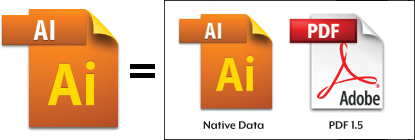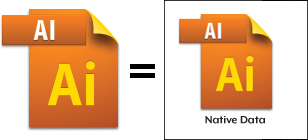When you save a document from Illustrator using any
of the file formats found in the Save or Save As dialog box, you are
able to reopen that file and edit it as needed. When you do, all native
information, by default, is preserved in the file. For example, if you
save a file as an EPS document, you can reopen the EPS file in
Illustrator and make edits to the file with no loss of functionality or
editability. Adobe calls this round-tripping, and working in this way has many benefits.
If you create a file in
Illustrator but you need to place it into a QuarkXPress document, you
can create an EPS file. Because an Illustrator EPS file is
round-trippable, you can place the EPS file into your QuarkXPress
layout, yet you can edit that same EPS file in Illustrator if you need
to make changes.
As you will find out, Illustrator accomplishes this by using what engineers call dual-path
files. This means a single file contains two parts in it: One part
contains the EPS data that QuarkXPress needs; the other contains the
native Illustrator information that Illustrator needs. As we explore the
different formats and their settings, this dual-path concept will
become clear.
The Native Illustrator (.ai) Format
By default, when you choose
to save a new file, the file format setting is Adobe Illustrator
Document (.ai). Whenever you create documents, it’s best to save them as
native Illustrator files, because they will always contain rich and editable information.
Note
When
creating documents that you plan to use as a base for other files, you
may choose to save your file as an Illustrator Template (.ait).
|
Up until Illustrator 8,
the native file format for Illustrator was based on PostScript (EPS),
but for a variety of reasons, with the release of Illustrator 9, Adobe
changed the native file format to be based on the PDF language. In fact,
Adobe is quick to tell you that a native Illustrator file can be opened
and viewed in Adobe Acrobat or the free Adobe Reader. Adobe also
advertises that you can place native Illustrator files directly into
InDesign layouts. It makes sense when you think about it, because if the
native file format for Illustrator is using the PDF language, then
placing it in InDesign is similar to placing a PDF file in InDesign.
In reality, though, the
native file format is a special flavor of the PDF language—a flavor that
only Illustrator can understand. Certain constructs exist in
Illustrator that do not exist in the PDF language, such as live blends,
Live Paint
effects, and perspective (these effects are all expanded when printed
or translated to regular PDF). You can think of the native file format
for Illustrator as a superset of the PDF language. If this is the case,
however, how is InDesign or Acrobat able to import and display native
Illustrator files? That’s where the dual-path concept comes in.
When you save a native file, Illustrator actually saves two files—a native Illustrator file (.ai) and a standard PDF file (Figure 1).
These two files are combined to appear as a single Illustrator file on
your computer. When you place the native Illustrator file into InDesign,
the application sees the PDF portion and uses that for display and
printing. When you reopen the file in Illustrator, the application sees
the native Illustrator portion and uses that for editing. In the end,
everyone is happy, and you get to work with a single file.

Note
The
two files in an Illustrator file print and display the same and are
identical except the native Illustrator version maintains more
editability in the Illustrator environment. |
To save your file as
a native Illustrator file, choose File > Save, and choose Adobe
Illustrator (ai) from the format pop-up menu. When you click Save, you
are presented with the Illustrator Options dialog box where you can
specify settings for how your file should be saved. These are described
in the section “Native Illustrator File Format Settings.”
Legacy Illustrator Formats
Illustrator CS5 allows you to
save your file so that it is compatible with a variety of previous
versions of Illustrator. Obviously, the older the version you specify,
the less editable your file will be. Specifically, you should be aware
of these distinctions:
Adobe introduced a
new text engine in Illustrator CS. If you save your file to any version
prior to Illustrator CS, your text is either broken apart or converted
to outlines.
Adobe
introduced transparency features in Illustrator 9. If you save your
file to any version prior to Illustrator 9, transparency flattening will
occur, resulting in a document that may be extremely difficult, or even
impossible, to edit.
Your file will print or
display correctly when you’re saving to older versions because the
appearance is always maintained. However, you are limited in what kinds
of edits you can make in your file. For this reason, we recommend you always
save a native CS5 version of your file to keep on your computer or
server for editing purposes. If someone else requests a file from you
that is compatible with a previous version of Illustrator, send them a copy of your file.
Native Illustrator File Format Settings
A variety of settings are available in the Illustrator Options dialog box (Figure 2), and depending on your needs for each particular workflow, you can adjust these settings.

Version. The Version pop-up menu allows you to choose which version of Illustrator you want your file to be compatible with.
Fonts.
When you’re saving a file, any fonts you use are embedded in the PDF
portion of the file. This allows other applications to print the file
without requiring the fonts. However, you still need the fonts installed
if you are going to reopen the file in Illustrator. This setting is
disabled when the Create PDF Compatible File option is deselected (see
the next description). At the 100% setting, Illustrator embeds only
those characters of a font that are necessary to print the text in your
document. Using
a setting much lower (such as to 0%) embeds the entire font, resulting
in a larger file.
Create PDF Compatible File.
The Create PDF Compatible File option embeds a full standard PDF 1.5
file in your Illustrator document. As just mentioned, this allows
applications such as Acrobat or InDesign to read and place native
Illustrator files. Deselecting this option effectively cuts your file size in half and also reduces how long it takes to save an Illustrator file (Figure 3).
If you use Illustrator for all your work and print directly from
Illustrator, you can disable this option to enhance performance and to
create smaller file sizes, but be aware that you won’t be able to place
your file into an InDesign layout. Even if you do deselect this option,
you can always reopen the file in Illustrator and resave the file with
the option selected.

Include Linked Files.
When you select the Include Linked Files option, any place-linked files
are embedded in your document. Although this means you can send the
file to someone without requiring any external links, it also means you
can’t easily update linked graphics anymore. This option also increases
file size because the images are now included in the file.
Embed ICC Profiles. The Embed ICC Profiles option includes any color profiles (including those from placed images) in your document.
Use Compression. The Use Compression option employs compression algorithms to your file to try to reduce file size.
Save each Artboard to a Separate File.
If your file contains multiple artboards, you can have Illustrator
create individual files for each artboard (or a specified range of
artboards). Alternatively, leaving this option deselected will result in
all your artboards being combined into a single large artboard when
saving to older versions (with guides indicating where the original
artboards were).
Transparency. When
you’re saving to an Illustrator 8 or Illustrator 3 format, transparency
flattening must occur in documents that contain transparency effects.
You can choose to discard the transparency effects completely (which
preserves path geometry), or you can choose to preserve the appearance
of your file. You can also choose from the list of available
transparency flattener presets.